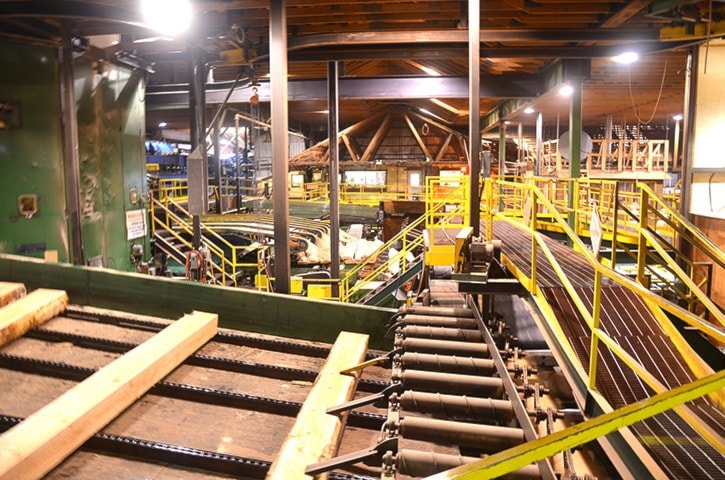U.S. housing construction starts have shown significant signs of revival since they collapsed in 2008, helping push up cedar and timber prices. The new activity has breathed new life into Downie Timber Ltd. after years of losses.
Owners, managers and workers at the privately-owned Revelstoke mill hope equipment upgrades completed in the approximately five-year hiatus from profit-making will better position them for an anticipated revival.
The number of shifts have increased, workers have been re-hired, and the forestry office is plotting new, more ambitions harvesting plans.
I recently visited the mill for a tour, with the goal of providing an update on the state of operations.
Human resources manager Stino Morabito lists off the new machines that have been installed in the past few years. A high-speed stacker, a lug loader, a grade scanner, and a big-log head-rig are a few of the expensive additions. The machines add capability, automate production and increase efficiency.
The grade scanner, for example, automates one stage of grading lumber by quality. The high-speed stacker whisks lumber through a giant metal framework, sorting automatically by size.
The plan is to be more efficient, competitive and even more flexible to capture the market rebound.
Dozens of mills across B.C. have closed or closed temporarily during the economic downturn. Morabito said it’s Downie’s flexibility that kept it operating. Many mills are only tooled to produce specific cuts of dimensional lumber. When market prices drop below their threshold, they become unviable.
Downie Timber Ltd. and Selkirk Cedar are tooled to create specialty products, and can change their products to meet market demand. Cedar, harvested locally in the Revelstoke-area inland rainforest, is their other key advantage; it’s a specialty species.
While the mill does produce spruce, fir and hemlock products, Morabito explains cedar is their bread and butter.
Downie Timber sales manager Rob Marusic’s office overlooks the mill. He confirms things are picking up.
“The outlook right now is pretty decent,” Marusic said. “It’s definitely a lot better than 500,000.” In early 2013, U.S. new housing unit starts reached about 970,000. It’s a far cry from the heady days of 2005–2006, when new starts approached two million units, but it’s up. The number of new starts slammed down to about 500,000 in 2009, and showed little sign of recovery until last summer.
Marusic notes more starts and higher cedar prices provided a shot in the arm for the Revelstoke mill in late 2012 and early 2013, although that’s waned a bit.
“It’s not all roses when you see high prices in cedar,” Marusic said. Higher prices push up the cost for consumers, making competing products – like manufactured patio deck planks – more attractive.
A weakening Japanese Yen, a sluggish UK economy and unexpected mid-summer malaise in the U.S. housing market have dampened demand, but Marusic said there is still cause for optimism. (Provincial officials have pushed aggressively for expansion into the Chinese market, but Downie has very limited trade there.)
Forestry supervisor Mary-Anne Pigeon wades through maps and documents as she plans a new cut in the Wood River area near the Kinbasket Reservoir. The planned new harvesting activity is notable because it’s much further from Revelstoke than other harvesting in the past few years. To keep costs down, Downie has been harvesting much closer to the mill.
“We’re hoping that lumber prices are going to go on the same,” Pigeon said. New stumpage rates introduced on July 1 caused some surprise; the formula amounted to a dramatic increase, something Pigeon believes the industry will have to grapple with.
From a forestry perspective, Pigeon said Downie Timber always struggles with higher forestry costs than across B.C. Steeper terrain, more challenging road-building, barging costs and added silviculture expense all drive up their costs.
The tour through the mill to witness the new machinery is fascinating – jump at the chance to go if you get the chance. The mill is an endlessly complex maze of heavy machinery that weaves over and under itself in a steel framework.
In some places, various processes are stacked three stories high. Below, a massive band saw makes initial cuts on a log; in the middle, raw lumber trundles along a conveyor belt to the grader; on top, the stacker sorts the lumber by width and dimension.
The process is coordinated by operators who toggle joysticks while scanning a bank of computer monitors. On the line, operators troubleshoot, clear jams and manually sort.
Millions have been invested in the past several years, but more is planned.
Outside, the giant mound of mulch grows. From most perspectives on the 35-acre property, it rivals Mount Begbie. It’s grown since burning was banned, and now local fire officials have stepped in to demand a solution to the fire hazard. (It requires some managing to keep it from burning, including coring to allow heat to escape.)
Morabito said the mill has been in talks with BC Hydro about developing an efficient system to burn the chips while generating electricity. Although it’s still in the planning stages, Morabito said the odds are pretty good the concept will move forward.
Mill managers are also considering building new dry kilns.
Morabity credits the staff at the mill for keeping things together during the challenging past five years. He also said the Gorman family, owners of the mill, have demonstrated their commitment to the Revelstoke institution through constant investment in the operation.
